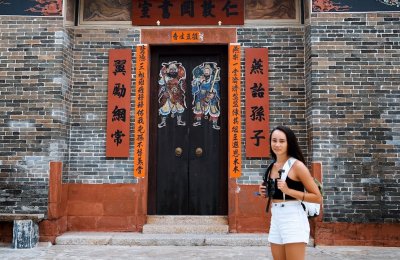New Data-Driven Journalism project by USC Annenberg and USC Viterbi School of Engineering Will Tell You
The most comprehensive database ever assembled on Los Angeles traffic is now accessible to drivers, journalists and policymakers, via a user-friendly platform built by the University of Southern California. Thanks to a new, data-driven journalism collaboration between the USC Annenberg School of Journalism and the USC Viterbi School of Engineering Integrated Media Systems Center (IMSC), the project, “Crosstown Traffic,” provides new insights on congestion, road accidents and public transport from 2012-2016.
Findings include:
- the most accident-prone roadways
- the most hazardous travel hours (Fridays between 4-6 pm)
- the worst interchanges
- the least “on-time” city bus (the 733)
“Crosstown Traffic” is the first interdisciplinary collaboration between USC Annenberg and USC Viterbi resulting from a 2016 grant from the Annenberg Foundation.
Since 2011, IMSC has developed a large-scale data platform for acquisition, storage, and analysis of LA-Metro's transportation with the USC Price School of Public Policy. Initial analyses completed by IMSC’s Associate Director, Ugur Demiryurek, were shared only with policymakers but Demiryurek wanted to make the information available to a broader audience.
He found the perfect partner in USC Annenberg professor and veteran journalist Gabriel Kahn, who incorporates data-driven journalism in his classes.
Data was mined from 17,000 street sensors on the main arteries and freeways across Los Angeles County and from transmitters on 2,000 buses. Undergraduate and graduate-level computer science students working under Demiryurek integrated, cleaned, sorted and analyzed 11 terabytes of traffic data (enough data to fill 11,000 trucks full of paper).
The IMSC computer science students then partnered with students in the USC Annenberg School of Journalism to discover trends, anomalies and patterns in the ways 10 million residents get around the region.
Together, the engineering and journalism students designed the “Crosstown Traffic” site and its affiliated customizable and downloadable data dashboards. In addition, the journalism students produced original stories about some of the most salient findings from the study:
- “The Most Dangerous Hour in LA”
- “The Worst Freeway Interchanges”
- “The Unbearable Lateness of Buses”
- “Why is this Freeway So Treacherous?”
“Crosstown Traffic is the result of exactly the kind of cross-school collaboration we want to foster through the Annenberg Leadership Initiative,” said Willow Bay, director of the USC Annenberg School of Journalism. “Combining the strengths of their fields, student journalists and engineers are weaving together storytelling and the power of data-mining for a real-world purpose. These are the communication and technology professionals of the future.”
USC Annenberg Professor Gabriel Kahn underscores the importance of transparency when it comes to traffic, an issue that impacts everyone in Los Angeles. He said, “Voters in the county just overwhelmingly chose to tax themselves last November in order to spend billions on new transit projects. But until now, they’ve had very little access to the data that will inform one of the largest-ever investments in public infrastructure.”
The findings, Kahn said, “have implications for everything from insurance to auto body repair.”
Cyrus Shahabi, director of IMSC said, “IMSC, as a data science research center at USC, focuses on data-driven solutions for real-world applications with major societal impact. This goal is well aligned with the Viterbi School of Engineering's concept of Engineering+. Our collaboration with Annenberg is a great example of how the IMSC transportation data platform enables new developments in journalism and provides real-life experience for both journalism and engineering students.”
The data for “Crosstown Traffic” will continue to be updated and refined. The next phase of Demiryurek’s research will provide Angelenos with more accurate real-time predictive traffic information. In addition, Demiryurek will develop analytics regarding the impact of events on traffic flow.
Crosstown Traffic has garnered widespread coverage by regional and national news outlets, including The New York Times, the Los Angeles Times, La Opinión, Business Insider, the LA affiliates KCBS-TV, KABC-TV, KNBC-TV, LAist, Curbed LA, KCRW-FM and the University Herald.
About the Annenberg Leadership Initiative
The Annenberg Leadership Initiative is a comprehensive program designed to bring a diverse pool of talent to USC Annenberg while driving the technological innovation, training and thought leadership that is needed throughout the media industry. The program funds the innovation teams of USC Annenberg and USC Viterbi students and faculty experts that created "Crosstown Traffic," and it also provides student scholarships and fellowships to working journalists from diverse backgrounds.
About the USC Viterbi School of Engineering
Engineering Studies began at the University of Southern California in 1905. Nearly a century later, the Viterbi School of Engineering received a naming gift in 2004 from alumnus Andrew J. Viterbi, inventor of the Viterbi algorithm now key to cell phone technology and numerous data applications. Consistently ranked among the top graduate programs in the world, the school enrolls more than 6,500 undergraduate and graduate students, taught by 180 tenured and tenure-track faculty, with 73 endowed chairs and professorships. http://viterbi.usc.edu/http://viterbi.usc.edu/
About the USC Annenberg School for Communication and Journalism
Located in Los Angeles at the University of Southern California, the Annenberg School for Communication and Journalism is a national leader in education and scholarship in the fields of communication, journalism, public diplomacy and public relations. With an enrollment of more than 2,200 students, USC Annenberg offers doctoral, master's and bachelor's degree programs, as well as continuing development programs for working professionals across a broad scope of academic inquiry. The school's comprehensive curriculum emphasizes the core skills of leadership, innovation, service and entrepreneurship and draws upon the resources of a networked university located in the media capital of the world.

